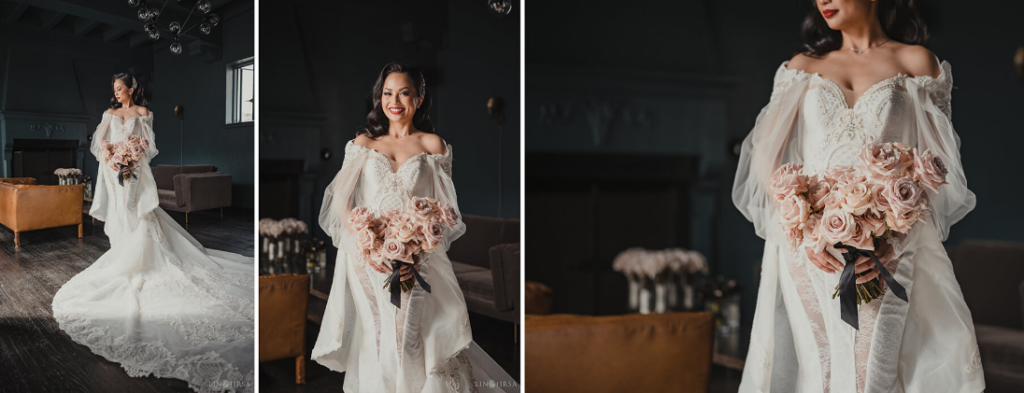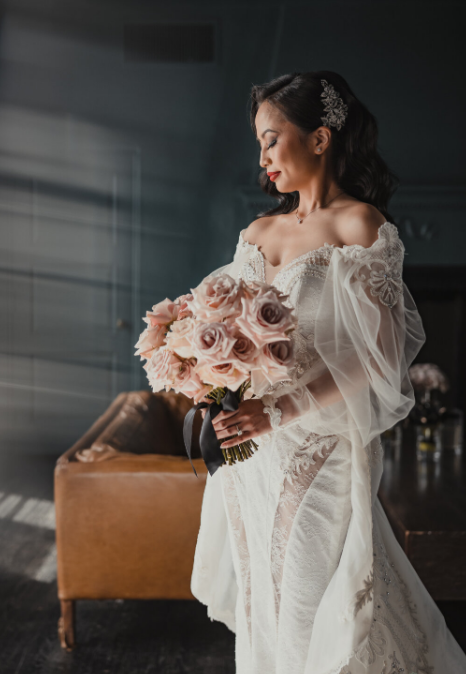Bridal portraits are formal photographs of the bride taken usually on her wedding. Wedding photography often includes bridal portraits as part of wedding preparation, after the photos of wedding details like the dress. This article will focus on tips and tricks for natural lighting wedding photography. These tips can be applied to many other situations.
In 4 easy steps, you can take better bridal portraits
Let’s first talk about C.A.M.P. Framework, developed by our friends at SLR Lounge. The C.A.M.P. Framework was developed by SLR Lounge. It’s what I use to plan out all my portrait sessions. This four-step, easy to follow system is something I would recommend you also use. Framework consists of these components:

- Composition: Think about how you would like the scene to appear, how you will place your subject and camera, which angle to take and what they might be doing.
- A- Ambient light: Decide your desired exposure for the scene, and adjust your settings
- Modify or add Light: You can modify the lighting (one at atime) or you can add more lights.
- Pose and Photograph: Guide your subject into a pose or expression, and take the picture.
The C.A.M.P. system combines the technical and artistic aspects of photography to create a simple and clear way for you to capture portraits. The bridal portraits are some of the best images captured on a wedding. In a situation such as this, the C.A.M.P. Framework can help to reduce the amount of stress.
Compose Your Bridal Portraits Frame

Natural light can be used to create dramatic portraits. Although flash photography offers many creative possibilities, you can also use natural light to produce dramatic portraits.
Here are some bridal portraits I took at Vibiana in Downtown Los Angeles, which is one of my favourite venues. This particular venue’s bridal prep room, which has deep blue walls, dark floors, and a dark ceiling, is perfect for dark, moody, and dramatic portraits. This was the perfect setting to capture bridal portraits. The main room has a large double door that leads to the patio. Both doors are swung open, and this provides a great light source. The dark background would be perfect for creating moody portraits of the bride. I also knew that I could light the bridal party and myself using ambient light. With a Canon RF28-70mm f/2 lens, I was able to capture everyone in the picture and have a large enough aperture for them to stand out from the background.

The natural light coming in the front door was on the left side of my camera. The bride and her subjects (if included) were placed 5-10 feet from the source of light. I directed them to slightly look toward it. After positioning my subject, I used the zoom lens on my camera to take a variety of shots, from wide to medium to tight, to get everything from full-body portraits to details up close. These different angles of view can later be used to create album spreads and wall art.
Find other angles & setups at the same location
In this same location, I used two other locations. One shot I had to change my position so that the backlight of the doorway would create a silhouette. Another shot was taken in the hallway to the left of the main space. In this photo, I placed the bride in front of a hallway window to illuminate her face. I then framed the head with a frame from a window at the other end.
In our earlier conversations, I had learned that the bride wanted and liked dark, moody images. Be sure to know the type of style that your client wants before you go rogue. You can match the style of your client’s photos to a suitable location once you have figured out what they want.

Step #2: Dial in ambient exposure Adjust the ambient exposure
We add light and manipulate it without really mastering what is right there in front us. The room where I took these bridal portraits had a double-door entryway, which provided me with all the ambient lighting I needed. The windows on the wall opposite the entryway also provided some rim lighting on my subjects.
Make it happen.
It wasn’t needed. I could have looked at a different spot and used an off-camera light, but that was not necessary. It was enough to stop the exposure on the camera and allow the window and door to provide the necessary light. A fast lens and wider aperture, in addition to making the image darker, allowed me to use a relatively low ISO, as well as a shutter speed that was fast enough to stop any movement, which, for this shot, was very minimal.

Modify or add light
The ambient lighting in the scene was sufficient. Due to the compositional decisions I had made, the only change I would make to the lighting is to shift my subject closer or further away from the source of light to achieve the desired balance between light and shadow.
Tips #4. Pose and photograph your subject
I think the ultimate goal of both candid and posed portraits is that they look as natural as possible. This includes their poses and facial expressions. In these photos, I chose a style that was more editorial for the bridal portraits. A candid style using looser expressions and poses for the group pictures. Our posing guide covers the basics of posing couples as well as how to achieve flattering facial expressions.

The Final Look
We can streamline our workflow when we know what our desired final shot will look like. Before I pick up my camera, I carefully position my subject to match my vision. Then, editing and shooting become effortless. These images were all shot with natural light, and then edited in Lightroom by using Visual Flow Presets’ Mood Pack. These images weren’t edited with Photoshop and no edit took more than 15 second in Lightroom.
The conclusion of the article is:
Lighting has a huge impact on what we photograph and the way that we do it. There have been many articles written about lighting, light patterns and the best way to capture natural or flash light. Spend the time necessary to build up your knowledge of photography now and you will save a lot later on when editing and capturing your photographs. This is the most effective way to prepare for success in real-world photography.